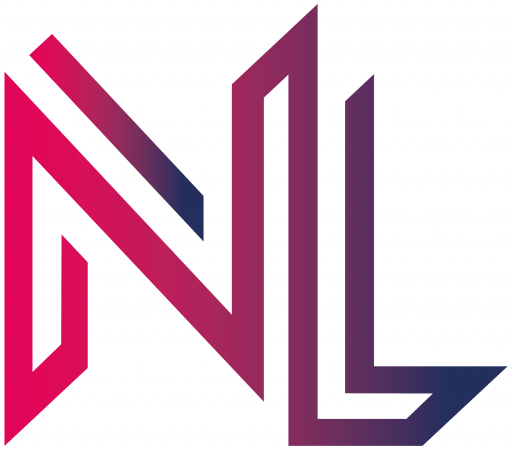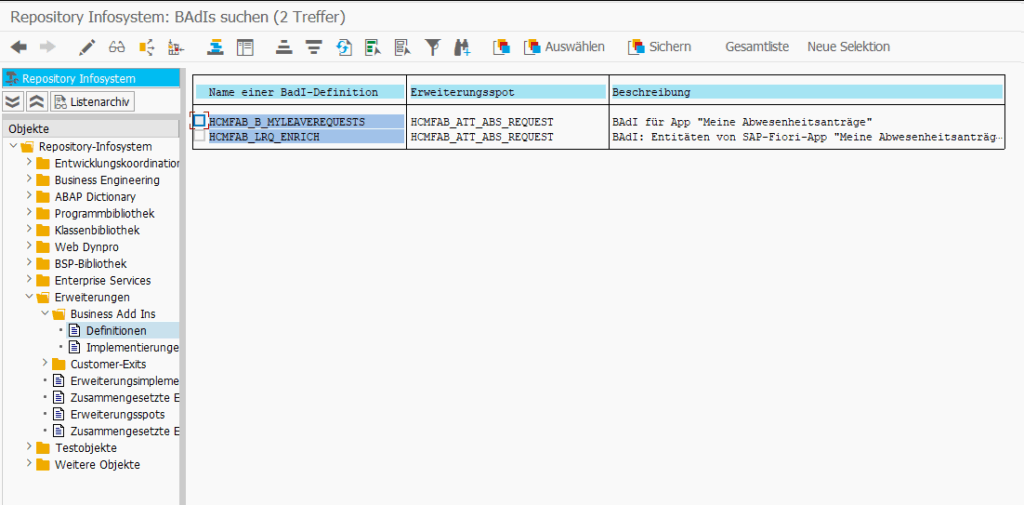* Option 1
DATA lt_data TYPE STANDARD TABLE OF x255.
CALL FUNCTION 'SCMS_XSTRING_TO_BINARY'
EXPORTING
buffer = lv_xstring
TABLES
binary_tab = lt_data.
* Option 2
cl_scp_change_db=>xstr_to_xtab( EXPORTING im_xstring = lv_xstring
IMPORTING ex_xtab = DATA(lt_data) ).
* Option 3
DATA(lt_data) = cl_bcs_convert=>xstring_to_solix( lv_xstring ).
Category: ABAP
ABAP
[ABAP] Selektionsparameter mit Suchhilfe für Personalnummern
Da ich es immer wieder nachschauen muss, schreibe ich es hier mal auf.
PARAMETERS p_pernr TYPE pernr_d OBLIGATORY MATCHCODE OBJECT prem.
[ABAP] Terminverfolgung IT0019 – Bemerkungen / Text auslesen


DATA infotype_text TYPE TABLE OF hrwpc_s_infotype_text.
CALL FUNCTION 'HRWPC_RFC_IT0XXX_TEXT_GET'
EXPORTING
pskey = CORRESPONDING pskey( p0019 )
TABLES
infotype_text = infotype_text.
DATA(text) = REDUCE #( INIT str = || FOR line IN infotype_text NEXT str = str && | | && line-textline ).
[ABAP] Sachbearbeiter ermitteln
Bisher kenne ich keine “offizielle” Klasse der SAP für die Sachbearbeiterermittlung. Auf jedem System dafür eine neue Helper Klasse/Methode anzulegen finde ich aber auch nervig. Ich nutze daher diese Klasse aus dem Notification Tool Paket P99_NT, nicht optimal, erfüllt aber seinen Zweck.
cl_hrpay00_nt_read_db=>get_admin_data( EXPORTING iv_pernr = pernr-pernr
IMPORTING es_sacha = DATA(es_sacha)
ev_usrid = DATA(ev_usrid)
ev_sbmod = DATA(ev_sbmod)
es_p0001 = DATA(es_p0001) ).
[ABAP] Read E-Mail-Template
Addition to https://nocin.eu/abap-e-mail-templates-in-s-4hana/
I had to create an E-Mail template where I did not need a CDS view or any variable at all. I simply needed the defined mail template without any rendering of class cl_smtg_email_api.
Solution: Reading the plain mail template can be achieved using class cl_smtg_email_template and method get_tmpl_cont:
DATA(ls_mail_content) = cl_smtg_email_template=>get( p_mailtx )->get_tmpl_cont( iv_langu = 'D' ).
Full sample:
PARAMETERS: p_mailtx TYPE smtg_tmpl_id OBLIGATORY.
TRY.
" get mail template
DATA(ls_mail_content) = cl_smtg_email_template=>get( p_mailtx )->get_tmpl_cont( iv_langu = 'D' ).
" optional: dynamic manipulation of html email body
" create mail document
DATA(lo_mail_document) = cl_document_bcs=>create_document( i_type = 'HTM'
i_subject = conv #( ls_mail_content-subject )
i_text = cl_bcs_convert=>string_to_soli( ls_mail_content-body_html ) ).
" create Sender & Receiver
DATA(lo_sender) = cl_cam_address_bcs=>create_internet_address( i_address_string = 'noreply@example.com'
i_address_name = 'Test' ).
DATA(lo_recipient) = cl_cam_address_bcs=>create_internet_address( i_address_string = 'max.mustermann@example.com').
" create Business Communication Service
DATA(lo_bcs) = cl_bcs=>create_persistent( ).
lo_bcs->set_document( lo_mail_document ).
lo_bcs->set_sender( lo_sender ).
lo_bcs->add_recipient( lo_recipient ).
lo_bcs->send( ).
COMMIT WORK.
CATCH cx_smtg_email_common INTO DATA(ls_cx).
DATA(lv_message) = ls_cx->get_text( ).
MESSAGE e899(id) WITH 'Unable to send message:'(004) lv_message.
ENDTRY.
[ABAP] Quick way to get last year’s BEGDA and ENDDA
Using method get_current_year of class cl_hcmfab_reporting_utility you can get BEGDA and ENDDA of the current year, e.g. 01.01.2025 and 31.12.2025
CALL METHOD cl_hcmfab_reporting_utility=>get_current_year
EXPORTING
iv_date = sy-datlo
IMPORTING
ev_begda = DATA(begda)
ev_endda = DATA(endda).
I couldn’t find a similar method to get the same for the last year. But I could solve the problem with three simple lines.
DATA(last_year) = conv d( sy-datlo - 365 ).
DATA(begda) = last_year(4) && '0101'.
DATA(endda) = last_year(4) && '1231'.
After that, I asked Perplexity and it gave me a similar result.
DATA(lv_last_year) = sy-datum+0(4) - 1.
DATA(lv_begda) = |{ lv_last_year }0101|.
DATA(lv_endda) = |{ lv_last_year }1231|.
Using this method, you could even reduce it to two lines, and it would still be easy to read.
DATA(begda) = |{ sy-datum(4) - 1 }0101|.
DATA(endda) = |{ sy-datum(4) - 1 }1231|.
[ABAP] Ermittle Sachkonto zu symbolischen Konto aus FI System
DATA(service_manager) = NEW cl_hrpp_ws_service_manager( ).
SELECT * INTO TABLE @DATA(lt_t52el) FROM t52el WHERE molga = '01' AND symko <> @space AND endda >= @pn-begps. " Verknüpfung Lohnart zu symbolischen Konto
SELECT * INTO TABLE @DATA(lt_t52ek) FROM t52ek. " Symbolische Konten
SELECT * INTO TABLE @DATA(lt_t52ep) FROM t52ep. " Kontierungsarten
LOOP AT lt_t52el INTO DATA(ls_t52el). " Ermittle je Lohnart die symbolischen Konten (1:n)
TRY.
DATA(ls_t52ek) = lt_t52ek[ symko = ls_t52el-symko ]. " Ermittele Kontierungsart
DATA(ls_t52ep) = lt_t52ep[ koart = ls_t52ek-koart ]. " Ermittele Typ des symbolischen Kontos
DATA(process) = CONV ktosl( 'HR' && ls_t52ep-kttyp ).
CATCH cx_sy_itab_line_not_found.
CONTINUE.
ENDTRY.
service_manager->hrpp_fi_acct_det_hr( EXPORTING companycode = pernr-bukrs
process = process " Vorgangsschlüssel
symb_acct = ls_t52el-symko
eg_acct_det = CONV #( '1' ) " Überleitung FI/CO: Mitarbeitergruppierung Kontenfindung: alle Mitarbeiter
IMPORTING gl_account_debit = DATA(account_debit)
gl_account_credit = DATA(account_credit)
return_tab = DATA(return_tab) ).
IF line_exists( return_tab[ type = 'E' ] ).
CONTINUE.
ENDIF.
" Lese Sachkonto Text
service_manager->hrpp_gl_acc_getdetail( EXPORTING companycode = pernr-bukrs
glacct = account_debit
language = sy-langu
text_only = abap_true
IMPORTING account_detail = DATA(account_detail) ).
ENDLOOP.
[ABAP] Enqueue and dequeue pernr
TRY.
DATA(messsage_handler) = NEW cl_hrpa_message_list( ).
cl_hrpa_masterdata_enq_deq=>enqueue_by_pernr( tclas = cl_hrpa_tclas=>tclas_employee
pernr = 1
message_handler = messsage_handler ).
cl_hrpa_masterdata_enq_deq=>dequeue_by_pernr( tclas = cl_hrpa_tclas=>tclas_employee
pernr = 1 ).
CATCH cx_hrpa_violated_assertion.
ENDTRY.


